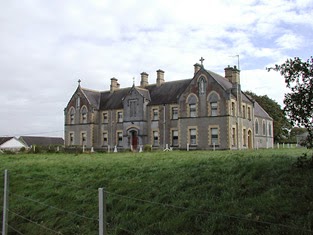19th Cent. Convent, Kilbeggan
Killbeggan in the barony of Moycashell on the river Brosna. The abbey was subsequently called de flumine Dei by allusion probably to that river. The ancient establishment of Killbeggan is attributed to St. Becan, brother of St. Cormac, of the royal blood of Munster, and of St. Evin of Ross, in the county of Wexford. In the life of St. Cormac mention is made of Becan Sanctus Becanus in Mumonia remanens monasterium de Killbeacain alias Cluan ard Mobecoc crexit et sanc tissime rexit. The highest encomiums are paid to his extraordinary sanctity the austerity of his life and the miracles which he wrought. We are told that he used to sing the whole Psalter every day whether dry or wet, cold or warm, by the side of a stone cross in the open air outside the monastery. St. Becan lived in the sixth century. His memory was revered on the 26th of May.
A.D. 1200 the family of Dalton founded a Cistercian abbey here under the invocation of the Virgin Mary and probably on the site of the ancient edifice. It was supplied with brethren from the abbey of Mellifont.
A.D. 1213 Melaghlin Mac Coughlan, prince of Delvin, died here in pilgrimage.
A.D. 1218 his sons died here.
A.D. 1236 Hugh O'Malone, bishop of Clonmacnois, died here.
A.D. 1298 the abbot William O'Finan was made bishop of Clonmacnois. Maurice Ó Shangane was the last abbot. In the thirty first of Henry VIII an inquisition was held and its property confiscated. Its possessions consisted of one thousand and twenty acres of wood arable and pasture, three water mills, nineteen messuages, eleven cottages and twenty six rectories. In the eleventh of Elizabeth eight carucates of this land were granted to Robert Dillon at the annual rent of £6 15s. The remainder had been parcelled out in 1618 by James I to different favorites to be held of the king as of the castle of Dublin in free and common soccage.
